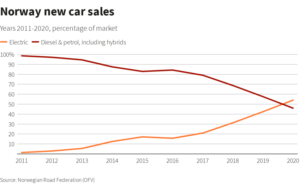On Wednesday, various U.S. and foreign automakers sided with the Environmental Protection Agency’s (EPA) new and tougher vehicle emissions regulations in a court hearing challenged by states and ethanol companies.
Texas and 15 other states filed a lawsuit against the EPA’s new rules stating the EPA was exceeding its authority and violating the U.S. Constitution’s separation-of-powers principle in setting the greenhouse gas emissions rules.
The EPA’s new rules entail a 10% reduction in vehicle emissions in model year 2023 and a 5% greater reduction every year until 2026. The EPA’s estimated goal is to decrease vehicle emissions by 28.6% by 2026. Alongside reducing emissions, the new rules will also encourage the adoption of more electric cars — something other countries have been doing liberally for years.
European countries have been dominating the transition to electric cars for years
In July of 2021, the European Union declared that it would cut 55% of carbon emissions by 2030 in an effort to reach their carbon neutrality goal by 2050 as part of the European Green Deal.
While simultaneously reducing emissions, the EU is also promoting the increase of electric vehicles.
According to the International Energy Agency, the market share of electric vehicles increased in Europe from 1.2% in 2016 to 10% in 2020 — Europe now having the current highest electric car market share above the U.S. and China.
Scandinavian countries are leading the charge toward electric vehicles with Norway having the highest amount of electric car sales globally in 2020.
Norway first set ambitious transition targets decades ago in the late nineties, proposing a target of 50,000 electric vehicles on the road by 2017. By 2015, two years before the set target year, Norway was able to accomplish the transition.
Most recently, Norway set a goal to be the first nation to end the sale of petrol and diesel cars by 2050 and replace them with electric vehicles. As of now, the transition is going smoothly, with 54.3% of all new cars sold in 2020 being electric — an astonishing record, up from 42.4% the previous year.

Many are attributing the Norwegian government’s success to the tax incentives in place for electric vehicles — encouraging consumers to buy electric.
Following close on Norway’s heels, according to a study conducted by the European Environmental Protection Agency and Eurostat, other EU countries that have significantly increased their electric vehicle sales in 2020 include the Netherlands by 22.91%, Sweden by 9.69%, Denmark by 7.19%, Germany by 6.86%, Luxembourg by 5.61% and several others — the UK not included in the study.
The study also predicted that both Norway and the Netherlands, if they continue on this trend, could reach 99.90% of all car sales being electric by 2035.
The EPA’s new emissions regulations could help America catch up to the electric vehicle trend — if they in win in court
Filed back in December of 2021, states contesting the EPA regulations include Texas, Alabama, Alaska, Arizona, Arkansas, Indiana, Kentucky, Louisiana, Mississippi, Missouri, Montana, Nebraska, Ohio, Oklahoma, South Carolina and Utah.
The states are also joined by several corn and soybean grower associations like the American Fuel and Petrochemical Manufacturers and ethanol companies.
Opponents to the regulations argue it is out of the EPA’s jurisdiction to make such harsh regulations.
Represented under The Alliance for Automotive Innovation, automotive companies backing the EPA’s decision in court include most of the big players in the car industry: Ford Motive Co., General Motors Co., Stellantis NV, Honda Motor Co. and Toyota Motor Corp. As of recently, The Alliance for Automotive Innovation said they were currently filing a motion with the District of Columbia Circuit Court of Appeals in support of the EPA.
As to why car companies joined the fight, automakers stated they wanted to ensure “critical regulatory provisions supporting electric vehicle technology are maintained.”
Great discussion w/ our Canadian partners about building a strong auto #supplychain and paving the way for #ElectricVehicles and next gen personal transportation. 🇺🇸🇨🇦 https://t.co/h2Fhqr4DyW
— Alliance for Automotive Innovation (@autosinnovate) March 23, 2022
If passed, the new regulations are supposed to reduce emissions 28.6% by 2026 — the regulations effective starting September. The regulations are part of the Biden Administrations’ plans that call for half of all vehicles sold in the U.S. to be capable of emission-free driving by the end of the decade.
Automakers are claiming that in order to make the transition, government investments and directives are required if electric vehicles are to be possible in the U.S.
John Bozzella, president and chief executive officer of the alliance, mentioned that if the US wants to reach its goal, this EPA regulation is essential.
“The country needs a range of supportive policies and other tools in place to accelerate the shift to electric vehicles and to enhance American competitiveness including regulatory components in this rule like EV multipliers and zero upstream emissions,” Bozzella said.
With automakers backing up the EPA, the new regulations and the Biden Administrations’ electric vehicle goals may have a fighting chance — at least hopefully. Currently, the US is the biggest polluter of carbon emissions globally, therefore it is crucial that steps are taken to reduce pollution as soon as possible if the climate crisis is ever going to be overcome.
Editor’s Note: The opinions expressed here by Impakter.com columnists are their own, not those of Impakter.com. — In the Featured Photo: Highway traffic lights on August 12, 2012. Source: an.yonghua, Flickr.










